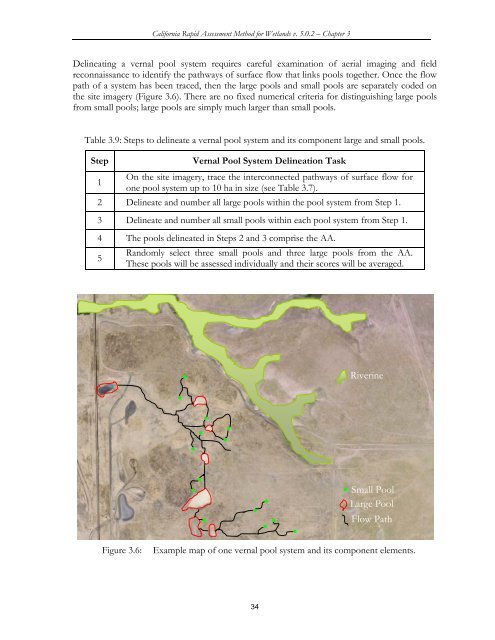(CRAM) For Wetlands User's Manual Version 5.0.2
(CRAM) For Wetlands User's Manual Version 5.0.2
(CRAM) For Wetlands User's Manual Version 5.0.2
Create successful ePaper yourself
Turn your PDF publications into a flip-book with our unique Google optimized e-Paper software.
California Rapid Assessment Method for <strong>Wetlands</strong> v. <strong>5.0.2</strong> – Chapter 3<br />
Delineating a vernal pool system requires careful examination of aerial imaging and field<br />
reconnaissance to identify the pathways of surface flow that links pools together. Once the flow<br />
path of a system has been traced, then the large pools and small pools are separately coded on<br />
the site imagery (Figure 3.6). There are no fixed numerical criteria for distinguishing large pools<br />
from small pools; large pools are simply much larger than small pools.<br />
Table 3.9: Steps to delineate a vernal pool system and its component large and small pools.<br />
Step Vernal Pool System Delineation Task<br />
On the site imagery, trace the interconnected pathways of surface flow for<br />
1<br />
one pool system up to 10 ha in size (see Table 3.7).<br />
2 Delineate and number all large pools within the pool system from Step 1.<br />
3 Delineate and number all small pools within each pool system from Step 1.<br />
4 The pools delineated in Steps 2 and 3 comprise the AA.<br />
Randomly select three small pools and three large pools from the AA.<br />
5<br />
These pools will be assessed individually and their scores will be averaged.<br />
Figure 3.6: Example map of one vernal pool system and its component elements.<br />
34<br />
Riverine<br />
Small Pool<br />
Large Pool<br />
Flow Path















